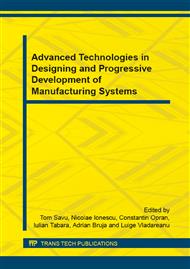p.293
p.299
p.305
p.311
p.317
p.323
p.329
p.335
p.341
Mechanical Properties of Polypropylene - REOGARD 2000® Composite
Abstract:
"New materials" as they are called composite materials are designed with special features to meet some special requirements regarding: mechanical strength and rigidity, resistance to corrosion, resistance to chemical agents, low weight, dimensional stability, resistance to varying loads, shock and wear, insulating properties and aesthetics. The main advantage of these materials is the high ratio between strength and weight density. This paper deals with the tests of a composite materials as polypropylene (PP) materials, firstly as pure and recovered polypropylene materials, and secondly, the same materials with the addition of 5%, 10%, 15%, 20%, 25% Reogard 2000®. This study led to the conclusion that the best mechanical properties of polypropylene is for 20% concentration of Reogard2000®.
Info:
Periodical:
Pages:
317-322
Citation:
Online since:
May 2015
Authors:
Keywords:
Price:
Сopyright:
© 2015 Trans Tech Publications Ltd. All Rights Reserved
Share:
Citation:


